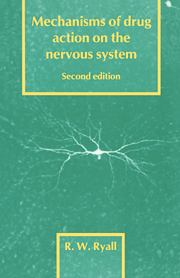Book contents
- Frontmatter
- Contents
- Preface to the second edition
- Preface to the first edition
- List of abbreviations
- 1 Introduction
- 2 Techniques
- PERIPHERAL NERVOUS SYSTEM
- CENTRAL NERVOUS SYSTEM
- 5 Central neurotransmitters and neuromodulators
- 6 The blood-brain barrier
- 7 General anaesthetics
- 8 Pain and analgesia
- 9 Drug interactions with inhibitory amino acids
- 10 Drugs used in schizophrenia
- 11 Affective and manic depression
- 12 Disorders associated with defined brain lesions
- Selected reading
- Index
5 - Central neurotransmitters and neuromodulators
from CENTRAL NERVOUS SYSTEM
Published online by Cambridge University Press: 08 October 2009
- Frontmatter
- Contents
- Preface to the second edition
- Preface to the first edition
- List of abbreviations
- 1 Introduction
- 2 Techniques
- PERIPHERAL NERVOUS SYSTEM
- CENTRAL NERVOUS SYSTEM
- 5 Central neurotransmitters and neuromodulators
- 6 The blood-brain barrier
- 7 General anaesthetics
- 8 Pain and analgesia
- 9 Drug interactions with inhibitory amino acids
- 10 Drugs used in schizophrenia
- 11 Affective and manic depression
- 12 Disorders associated with defined brain lesions
- Selected reading
- Index
Summary
This chapter is devoted to a consideration of some basic aspects of transmitter action which are not treated elsewhere in this book. A more detailed treatment of opiate, GABA, benzodiazepine, 5–HT and dopamine receptors will be found in Chapters 8–11.
Of the large number of drugs which act upon the central nervous system, many appear to do so by an effect upon synaptic transmission. In the evolution of the nervous system a variety of chemical substances have assumed the role of chemical mediators and some of these have become associated with particular functions to a variable extent, although there is considerable overlap. Perhaps as a consequence of this specialisation, derangement of neuronal functions may sometimes be associated with defects in the operation of one transmitter system whilst others appear to operate in a more or less normal fashion. Drugs which act in the most selective fashion are therefore likely to be those with the most specific site of action on a process which in turn is relatively specific for a particular transmitter. Such drugs could act either by modifying selective binding of the transmitter to its receptor site or by effects on the synthesis, degradation or release of the transmitter. They could also operate on processes subsequent to the binding of the transmitter to its receptor but uniquely associated with that transmitter. The overlapping functions of neuronal pathways utilising the same transmitter leads to the generalisation that drugs selectively operating upon a transmitter system may affect a number of functions not all of which are necessarily deranged in disease.
- Type
- Chapter
- Information
- Mechanisms of Drug Action on the Nervous System , pp. 80 - 92Publisher: Cambridge University PressPrint publication year: 1989

